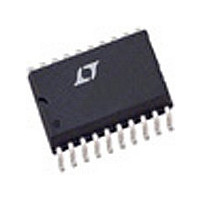LTC1753CSW#TRMPBF Linear Technology, LTC1753CSW#TRMPBF Datasheet - Page 15

LTC1753CSW#TRMPBF
Manufacturer Part Number
LTC1753CSW#TRMPBF
Description
Manufacturer
Linear Technology
Datasheet
1.LTC1753CSWTRMPBF.pdf
(24 pages)
Specifications of LTC1753CSW#TRMPBF
Lead Free Status / RoHS Status
Compliant
Available stocks
Company
Part Number
Manufacturer
Quantity
Price
APPLICATIO S I FOR ATIO
in the R
cost and circuit efficiency while increasing MOSFET heat
sink requirements.
Inductor Selection
The inductor is often the largest component in the LTC1753
design and should be chosen carefully. Inductor value and
type should be chosen based on output slew rate require-
ments, output ripple requirements and expected peak
current. Inductor value is primarily controlled by the
required current slew rate. The maximum rate of rise of
current in the inductor is set by its value, the input-to-
output voltage differential and the maximum duty cycle of
the LTC1753. In a typical 5V input, 2.8V output applica-
tion, the maximum current slew rate will be:
where L is the inductor value in H. With proper frequency
compensation, the combination of the inductor and output
capacitor will determine the transient recovery time. In
general, a smaller value inductor will improve transient
response at the expense of increased output ripple voltage
and inductor core saturation rating. A 2 H inductor would
have a 0.9A/ s rise time in this application, resulting in a
5.5 s delay in responding to a 5A load current step. During
this 5.5 s, the difference between the inductor current and
the output current must be made up by the output capaci-
tor, causing a temporary voltage droop at the output. To
minimize this effect, the inductor value should usually be
in the 1 H to 5 H range for most typical 5V input LTC1753
circuits. To optimize performance, different combinations
of input and output voltages and expected loads may
require different inductor values.
Once the required value is known, the inductor core type
can be chosen based on peak current and efficiency
requirements. Peak current in the inductor will be equal to
the maximum output load current plus half of the peak-to-
peak inductor ripple current. Ripple current is set by the
inductor value, the input and output voltage and the
operating frequency. The ripple current is approximately
equal to:
DC
MAX
DS(ON)
V
IN
calculations will generally decrease MOSFET
L
V
OUT
U
U
1 83
L
W
A
s
U
f
L
Solving this equation with our typical 5V to 2.8V applica-
tion with a 2 H inductor, we get:
Peak inductor current at 11.2A load:
The ripple current should generally be between 10% and
40% of the output current. The inductor must be able to
withstand this peak current without saturating, and the
copper resistance in the winding should be kept as low as
possible to minimize resistive power loss. Note that in
circuits not employing the current limit function, the
current in the inductor may rise above this maximum
under short circuit or fault conditions; the inductor should
be sized accordingly to withstand this additional current.
Inductors with gradual saturation characteristics are often
the best choice.
Input and Output Capacitors
A typical LTC1753 design puts significant demands on
both the input and the output capacitors. During constant
load operation, a buck converter like the LTC1753 draws
square waves of current from the input supply at the
switching frequency. The peak current value is equal to the
output load current plus 1/2 peak-to-peak ripple current,
and the minimum value is zero. Most of this current is
supplied by the input bypass capacitor. The resulting RMS
current flow in the input capacitor will heat it up, causing
premature capacitor failure in extreme cases. Maximum
RMS current occurs with 50% PWM duty cycle, giving an
RMS current value equal to I
capacitor with an adequate ripple current rating must be
used to ensure reliable operation.
OSC
O
I
11 2
= Inductor value
RIPPLE
300
= LTC1753 oscillator frequency = 300kHz
2 2 0 56
A
kHz
2
2
A
2
V
IN
f
H
OSC
12 2
V
OUT
2
L
A
A
O
P-P
V
V
IN
OUT
OUT
/2. A low ESR input
LTC1753
15
1753fa

















